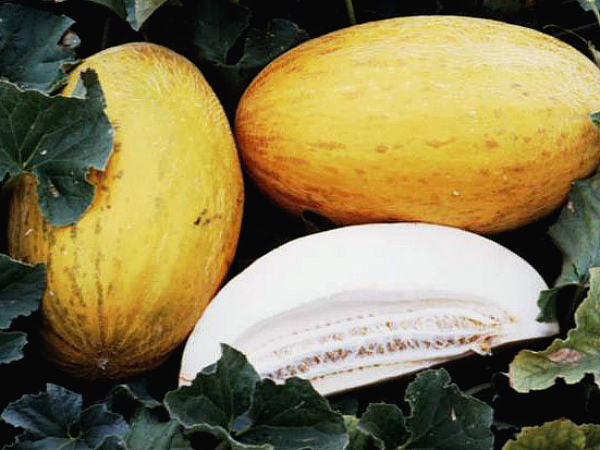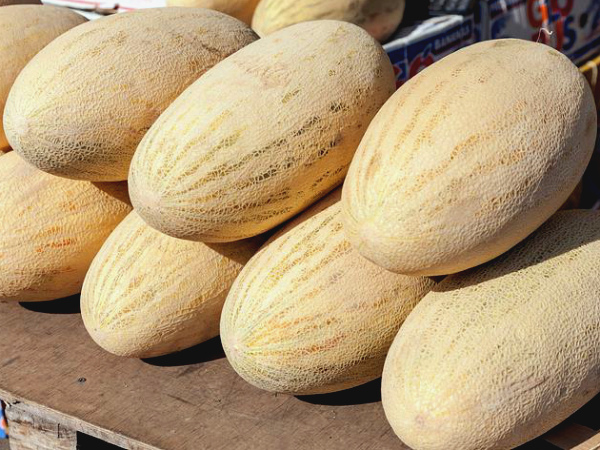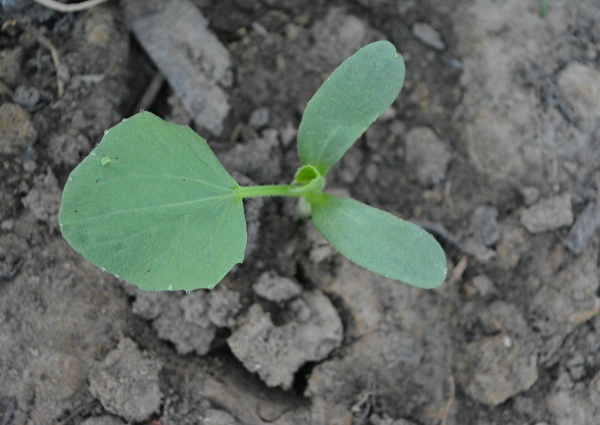Features of the torpedo melon variety
Content
About the grade
Central Asia is considered the birthplace of the torpedo. In these countries it is called in its own way, for example, in Uzbekistan it is called "Mirzanchulskaya". By the way, Torpedo is also a popular name. Obviously, the melon was so nicknamed for its elongated shape, vaguely reminiscent of the shell of the same name. We call this culture "Rainbow melon", and it tastes slightly different from the real Uzbek torpedo. And this is not surprising, since the climate in our latitudes is not so hot, and, accordingly, the fruits are not so sweet.
Melon Torpedo is a late-ripening variety. In our latitudes, it takes at least 90 days for it to fully ripen. In Asian countries, where the climate is dry and hot, its fruits ripen faster - by mid-August. This variety is very thermophilic, and if grown under suitable conditions, the fruits can reach a weight of 10-15 kg. However, we rarely manage to grow more than 5 kg of pumpkin.
Outwardly, these melons are very attractive. Ripe fruits have an intense yellow color with thin white veins forming a net pattern. The rind is dense, of medium thickness, resistant to damage, thanks to which the variety is well transported. The pulp is white, sweet, slightly oily, very juicy and aromatic.
The Torpedo variety is distinguished by powerful, intensively growing shoots. Young lashes of plants grow over 2 meters, so supports are often built for the bushes, along which they weave. The yield of the variety is 2.5–3 kg per square meter.
Beneficial features
Basically, any melon is considered a low-calorie and very healthy food product. Torpedo is a sweet variety that has the maximum calorie content among other types - 35 kcal / 100 g. This is a low calorie value, so the fruits can be consumed without restrictions even by overweight people.
The pulp of the fruit is 90% water - which is why they quench thirst so well. It also contains a lot (7.5 g) of carbohydrates, but they are all simple and quickly digestible. The amount of proteins and fats is minimal - 0.6 and 0.3 g, respectively. Ripe melon contains organic acids, a lot of dietary fiber, pectins, enzymes that improve intestinal function, as well as the entire set of B vitamins, vitamins A, C, P, PP.
The mineral composition is represented by potassium (118 mg), chlorine (50 mg), sodium (32 mg). Less amounts of calcium, magnesium, sulfur, phosphorus, sodium are contained. Of the microelements in the pulp of the fruit, there are: iron, iodine, copper, cobalt, manganese, fluorine.
Its rich and varied chemical composition explains why this melon is so beneficial to health. It has the following effect on the human body:
- normalizes bowel function, improves digestion;
- removes excess fluid, toxins, toxins, with prolonged use, relieves of salt deposits in the joints;
- enhances immunity;
- stabilizes the activity of the nervous system, improves mood, relieves depression;
- strengthens the heart and vascular walls, removes excess cholesterol;
- increases hemoglobin and promotes early recovery after diseases, operations.
Nutritionists recommend using this variety for fasting days. Since the fruit pulp is very sweet and watery, the product can be considered ideal for dietary nutrition.
It is important to know: Torpedo melon is recommended to be consumed separately from other products. You should not drink milk, fermented milk drinks, water or alcohol after it, and the interval between meals should be at least 2 hours.
How to choose
For residents of the regions where this variety is grown, the choice of high-quality and ripe fruits is not difficult. But in many cities, especially large ones, imported melons are sold in the markets, and they appear there before the season begins. In this case, how to choose a high-quality and healthy product, and why does the melon bought on the market so often disappoint us?
There are several guidelines, thanks to which you can choose a good fruit yourself:
- Since the Torpedo variety is late ripening, it should be bought not earlier than the end of August, but best of all in September. The fruits sold in the markets in the middle of summer contain many harmful substances that are used to accelerate ripening.
- Another important point: melons, like all melons, quickly accumulate harmful chemicals that stimulate growth and maturation. If there are green streaks on the yellow peel, this means that the fruit was grown with the use of nitrates.
- The ripe fruit has a uniform yellow color. Greenish spots indicate incomplete ripeness of the fruit. Brown spots and dents are a sign that the product is starting to deteriorate.
- The peel of a fully ripe Torpedo should be slightly springy to the touch. You should not buy fruits with scratches, small dents, cracks.
- You can check the melon for ripeness by tapping on the peel - if the sound is muffled, it means that the fruit is ripe.
- The seeds inside a ripe fruit have a yellowish tint and are easily separated from the pulp.
- The flesh of a ripe torpedo is white and soft. If there is a yellow stripe under the peel, it means that the culture was fed with saltpeter. A green streak is a sign that the fruit was picked too early.
- White in appearance, but bitter flesh indicates that the melon has begun to deteriorate.
- The stem of the fruit should be firm but dry.
- A bright orange peel in the absence of the characteristic melon aroma is a sign of excessive treatment of the soil with urea. Real torpedo melon exudes an incomparable aroma, reminiscent of a mixture of vanilla, pear and honey.
Do not buy fruit from dubious sellers, as well as in places that are not intended for selling products: along roads, outside the market.
Choose only yellow and aromatic fruits. Remember that overripe melon does not last long, so ask the seller how many days ago it was picked. Of course, it is more useful and safer to grow melons at home on your site, but if this is not possible, then try to protect yourself from an unsuccessful purchase.
Video "Choosing Melon Torpedo"
This video will teach you how to choose the ripe fruit correctly.
Growing features
As already mentioned, a hot climate is best suited for Torpedo melon. In the middle lane, and even more so in the northern regions, this variety is recommended to be grown in stationary greenhouses or hotbeds.
Since the melon has a shallow root system, it is enough for it to dig up the ground to a depth of 20 cm. When digging, it is necessary to add peat and humus. If the cultivation takes place in a greenhouse, then it is necessary to specially prepare a fertile soil mixture from 1 part of black soil and peat and 3 parts of humus.
Seeds are germinated before planting, planted shallowly - by 1.5-2 cm.In a small garden bed near the house, the holes can be placed at a distance of 50–80 cm, but this pattern is the main reason why the fruits grow small. In the field, plants are planted at a distance of 1–1.5 m - this distance is considered ideal, since the lashes grow strongly.
At home, it is more correct to grow this melon through seedlings. Since it is a late variety, planting seeds in pots in early spring will help grow an earlier crop. It must be remembered that young shoots do not tolerate transplanting well and adapt for a long time, therefore, it is better to plant seedlings in disposable containers from which the plants are easily taken out along with the ground.
Melon cultivation of this variety will be successful if you follow some agricultural rules:
- while the plants are young and have not yet unraveled, the soil in the aisles must be regularly loosened;
- plants are watered in a different mode (while the greens are actively growing, watering should be regular and intense, during flowering and the formation of ovaries, watering is needed less often, and when the fruits begin to ripen, watering is carried out only if the soil is dry);
- about 1 time / 1 month, the bushes are fed with mullein solution, and on poor soil, for example, in the field, a little compost can be embedded in the aisles.
The most important agronomic technique for growing melons is pinching the shoots and removing weak and excess ovaries. As soon as 5 true leaves appear on the plant, pinch off the shoot over the fourth leaf. When new shoots appear from the axils of the remaining leaves, they do the same with them, leaving only the two strongest side lashes. Further, the overgrown shoots are pinned to the soil surface so that additional roots are formed, and the plant itself becomes strong and powerful. On each bush, 5–6 of the largest ovaries are left, and the rest, small and weak, are removed.
Often, trellises are installed for melons of this variety. This support provides plants with constant access to sun and heat.
Video "Tasting Melon Torpedo"
Watch a short review about Torpedo melon, which ends with a tasting.







